
–– The newsletter on wine and wine travel ––
–– Read by wine lovers and wine professionals all over the world ––
–– On the internet since 1996 ––
Unnecessary and vital items in the kitchen
 We all have unnecessary things in the kitchen. The pasta machine that you used only once, a malfunctioning espresso machine. Maybe a sous vide machine that was thrilling for a couple of weeks. Many wine gadgets are also unnecessary. Take port tongs, for example; it is not an essential item for any of us.
We all have unnecessary things in the kitchen. The pasta machine that you used only once, a malfunctioning espresso machine. Maybe a sous vide machine that was thrilling for a couple of weeks. Many wine gadgets are also unnecessary. Take port tongs, for example; it is not an essential item for any of us.
Actually, isn’t it enough to have a good corkscrew? More or less, yes.
However, it is essential also to have good glasses. But one or two different types are enough. We have a slightly smaller glass for aperitifs and sparkling wines and another, slightly larger one, for the meal, the same for reds and whites.
Fortunately, we haven’t felt tempted to buy different glasses for different types of wine. We often play the game of letting one of us taste the dinner wine blindly. How would that work if you immediately see that the wine is served in a Chianti glass? Glass fetishism is more a kind of brand snobbery than a way to taste the wine better.
DropStop is a fantastic invention and good to have and doesn’t take up much space. But one should sometimes practice pouring without. A champagne sealer is definitely necessary. You have to be able to take a glass of bubbly as an aperitif and then close the bottle and keep the bubbles.
Do you need a wine thermometer? Not really. But it can be interesting to see from time to time if one’s perception of how warm/cold a wine is, corresponds with reality. On the other hand, the technical temperature does not really matter. The only thing that is important is that you think the wine has the right temperature when you drink it.
Wine gadget inventors are creative. By decanting through a filter, it is said that you can get rid of any sulphur in the wine. And there is an infinite number of “wine aerators”. Some are said to give the wine a maturity that usually requires several years in the cellar. There are also various metal discs that you immerse in the wine and which “quickly age” it, a fast-forward time machine for wine. Yes?
Vacuum pumps? No, logically, a vacuum in the bottle should make the volatile aromas disappear faster. Most wines will anyway last a week in an opened bottle in the fridge. Unless you drink it, of course. If anything, you can use a neutral gas, although that 300 euro gadget doesn’t tempt us.
Nor does any other of those fast-ageing, sulphur-removing clever miracle invention.
What about you? Do you have any wine gadgets that you really think are indispensable? Or maybe some that you never even took out of the box?
Brief of the Month
This month, you get more to read than ever before in the Brief. If you do not have time right now, save it and read later.
We have, for example, our two new articles series:
One where we explain what organic wine is, and also biodynamic, natural and sustainable. Most of what you may have read is not really accurate. We are always amazed that so many people misunderstand what organic wine really is. If you want to know, then read our article series.
The second series is about grape varieties. We present some of the world’s most important grape varieties, important either because they are some of the world’s most planted or because they are particularly interesting. For each grape variety, we also give you suggestions for wines that you can taste to learn the flavours better.
But we have lots of other articles and news in this Brief too, about glaciers, attacking birds, forest fires, Swedish wine, GDPR, exclusive vinegar and much more.
Travel
Right now, it’s pretty calm on the travel front. We are beginning to long to get out into the wine regions again. How about you? Does it feel too long since you were on a wine tour? This coming autumn, we only have a few tours. It goes without saying that we follow all advice and recommendations on health and safety.
By next year, we hope that the situation will improve so that we can all travel a little more freely. We have the spring wine travel program ready, with two great classics. The autumn program is also partly ready, but there will be more, so keep your eyes open.
We hope to meet you soon on a wine tour.
Enjoy the Brief!
Britt & Per
What’s on at BKWine Tours
BKWine is also one of the world’s leading wine tour operators. Here’s what we currently have on our scheduled wine tour program:
- South America, Chile and Argentina, January 18 – 31, 2021
- New Zealand, February 18 – March 5, 2021
- South Africa, March 17 – 26, 2021
- Bordeaux, April 21-25, 2021
- Champagne, May 19-23, 2021
- Champagne, September 22-26, 2021 (possible combination with Bordeaux)
- Bordeaux, September 29 – October 3, 2021 (possible combination with Champagne)
We also make custom designed wine tours.
We’re different than most other wine tour operators. We are people who know wine inside out, who travel constantly in wine regions, who write award winning books about wine. Who do this out of passion. Our tours are different from others. More in wine tours: BKWineTours.com.
Read our books
We have written several wine books, ten at the last count. Unfortunately, only one of them has been translated to English; the others are (so far) only available in Swedish. This is the one that is available in English:
All our books are on wine, but on different subjects: wines of the Languedoc, wine growing and wine making, the wines of France, Tuscany, Bordeaux, Piedmont, Burgundy, Champagne. Several have won prestigious prizes and awards from Gourmand International, OIV and others. Read more on our wine books.
News from the world of wineWhat’s been happening in the world of wine recently. |
Reader question: Good pinotage, South Africa’s own grape
A few tasting suggestions: Kanonkop is one of the classical pinotage producers. Look for the flagship Kanonkop Pinotage and the less expensive Kadette Pinotage. Also, in Stellenbosch, Kaapzicht and Bosman make fabulous pinotage. Down in Walker Bay on the South Coast, Springfontein Pinotage shows clearly the brilliance of their winemaker Tariro Masayiti. But there are plenty to choose from. Travel: Join us at BKWine on a wine tour to South Africa and you will discover some of the best pinotage there is. |
Is it cheating to mix organic and conventional farming?
Several organic producers and organisations reacted to the proposal with outcry. They believe that consumers would lose confidence in organic farming. Besides, organic farming is a mind-set, not something you (only) do for economic gain, they say. Are they right? Is it cheating to mix organic and conventional farming? Read more: vitisphere Read: Read more on organic wines in our new article series. Read 2: If you want to know more you can read our book on organic, biodynamic and natural wines. Travel: Meet the wine producers in Bordeaux and ask them on a wine tour with BKWine. |
Northern California wild-fires: Can grapes be smoke tainted?
|
Biocontrol in the vineyard, a natural alternative
Sulphur, copper and sexual confusion are all well-known biological control products/methods. Other types of products are based on microorganisms and macro-organisms. Microorganisms are bacteria, viruses and fungi that protect against pests and diseases. They can also stimulate the vitality of the plant. Macro-organisms are nematodes, insects or spiders that are used against pests. Biological control products, like all plant protection products in the EU, must be approved for use. But today they have an accelerated approval process. They are, however, not automatically approved for organic farming. Read more: agriculture |
Viña San Pedro makes wine to save Chile’s glaciers
Viña San Pedro is Chile’s second-largest wine producer with 4,270 hectares in Chile and just over 1,000 hectares in Argentina. South Cause is part of a larger environmental project which means e.g. that San Pedro will reduce the environmental impact from bottles and packaging. The project includes reducing the weight of bottles, by 2030 only use packaging materials that can be reused or recycled, increasing consumer awareness by writing recycling instructions on all our labels. Read more about South Cause from Viña San Pedro here: thedrinksbusiness Travel: Come and join us at BKWine in Chile (and Argentina) and explore their vineyards and beautiful landscapes. |
Growers from Alsace, Champagne and Burgundy, come to Copenhagen in October
The tasting takes place between 11 am and 5 pm. Read more about it here wine4trade |
How best to protect your vineyards from birds that love sweet grapes?
In those countries that have problems, it is common to protect the grapes from bird-attacks with netting. You can also use visual scare tactics, such as stuffed birds of prey. You can install a “cannon” in the vineyard that regularly gives off loud bangs and thus hopefully scares away the birds. The latest technology is to use a drone. Maybe this will prove to be both more efficient and less expensive. However, a recently published report shows the importance of understanding bird psychology. The drone had the best result if it combined several different scare tactics. The drone was equipped with both a speaker that sent out distress calls and a stuffed crow hanging under it. This way, the birds will better remember all the dangers lurking in that particular vineyard. Read more about how to scare away birds in the vineyard with a drone: ciencia-e-vinho |
FeaturesArticles and features published on BKWine Magazine and on our wine travel blog and photography blog in the last month. |
What – really – is organic winegrowing?
If you want to know more about what organic viticulture is, read Britt’s article on BKWine Magazine: Organic viticulture, what is it really? | part 2. Read: If you want to know more you can read our book on organic, biodynamic and natural wines. |
Domaine Agrovision, Greek wine overlooking Mount Athos
Read more in Britt’s article on BKWine Magazine: Domaine Agrovision, Greek wine overlooking Mount Athos. |
Hällåkra Vingård breaks new ground for Swedish wines
Read more on this Swedish wine producer in Sven-Olof Johansson’s article on BKWine Magazine: Ambitious wine and food at Hällåkra Vingård in Skåne, Sweden. |
Learn the taste of syrah
We give you a suggestion for a wine tasting to illustrate the characteristic in Britt’s article on BKWine Magazine: Learn the taste of syrah. Travel: Come and join us at BKWine on a wine tour to New Zealand or Chile-Argentina, countries that have outstanding syrah wines. |
Organic wine: in the wine cellar | part 3
Learn the truth – without scaremongering – about the work in the wine cellar in Britt’s article on BKWine Magazine: Organic wine: in the wine cellar | part 3 Read: If you want to know more you can read our book on organic, biodynamic and natural wines. |
Luxury in a small bottle: Traditional Balsamic Vinegar of Modena | Britt on Forbes
Read more on this delicious and exclusive “vinegar” in Britt’s article on BKWine Magazine, originally published on Forbes: Luxury in a small bottle: Traditional Balsamic Vinegar of Modena | Britt on Forbes. |
Chardonnay: a versatile, loved and loathed grape | grape variety profile | Britt on Forbes |
Some thoughts about how to write better about wine and travel
Read Per’s article on BKWine Magazine that is a summary and an extension of that discussion: Should Wine Writing Involve More Travel Writing? (At the Wine Media Conference). Should Wine Writing Involve More Travel Writing? (At the Wine Media Conference) |
Tempranillo, Spain’s hard-working superstar grape | grape variety profile | Britt on Forbes |
Three new “cru” from Marchesi Mazzei in Chianti Classico
Read more in Åsa Johansson’s article on BKWine Magazine: Three new “cru” from Marchesi Mazzei in Chianti Classico. |
Make a tasting: discover all the nuances in Chardonnay
Get Britt’s wine tasting tips in the Article on BKWine Magazine: Chardonnay: learn its taste with wines from 5 countries. Travel: The best way to learn about chardonnay is to travel, for example to Chile-Argentina or to South Africa. |
Organic certification | part 4
Although organic farming is increasing, it is still what we call conventional agriculture that dominates, where you can use synthetic chemical products. Therefore, organic producers need to be able to prove that they work organically according to the official rules of the EU. To get this proof, you have to obtain a certification. You then have the right to put on the label and in your marketing material that you are organic. If you are not certified, you are not allowed to claim to be organic. Read more in Britt’s article on BKWine Magazine: Organic certification | part 4. Read: If you want to know more you can read our book on organic, biodynamic and natural wines. |
Merlot – a grape variety profile |
Bodegas Weinert in Mendoza is a malbec specialist, making some curious wines
Read more in Britt’s article on BKWine Magazine – including four original videos – first published on Forbes: Making unusual and extraordinary malbec wine at Bodega Weinert in Mendoza | Britt on Forbes. Travel: Explore top-quality malbec on a wine tour to Argentina-Chile with us at BKWine. |
New privacy policy, and how to solve the GDPR conundrum on a website
For those who are interested in the technology, we have also described what we did to solve the “problem” with GDPR. Our sites are built on WordPress and there are many different tools. Here we describe what we did: Getting a cookie banner and making the site GDPR compliant. |
Wine ToursSome information on our current and future wine tours. Book a wine tour with the “world’s top wine tour operator” today (or when you feel like travelling to wine country). |
Swap cold winter for warm summer on a New World wine tour this winter | wine toursWe have three tours to the southern hemisphere on the program this winter. It is still a bit unclear whether these will be possible. We follow closely what is happening in the world. The three tours will take as to Chile-Argentina, New Zealand and South Africa, interesting wine countries to visit both for their stunning nature, the great wines and the good food. And of course, thanks to the many interesting wine growers we will meet. Chile and Argentina, January 2021
Travel: South America, Chile and Argentina, January 18–31, 2021 New Zealand, February 2021
Travel: New Zealand, February 18–March 5, 2021 South Africa in March 2021
Travel: South Africa, March 17–26, 2021 |
European wine tours spring 2021 and a preview of the autumn: Bordeaux and ChampagneFor the spring 2021 we are offering two wine tours to classic French wine regions: Bordeaux and Champagne. By then we hope and expect that the world has returned to a little bit more of a normal situation. We would love to see you in spring 2021, or, of course in the autumn of 2021: Bordeaux, behind-the-scene of grand chateaux | wine tour
Wine tour to Bordeaux, April 21-25, 2021 Wine tour to Bordeaux, September 29 – October 3, 2021 (This autumn tour will also be offered in combination with the Champagne tour; more details will soon be available on our website) Champagne, a wide variety of styles | wine tour
Wine tour to Champagne, May 19-23, 2021 Wine tour to Champagne, September 22-26, 2021 (this tour will also be offered in combination with the Bordeaux tour; more details will soon be available on our website) |


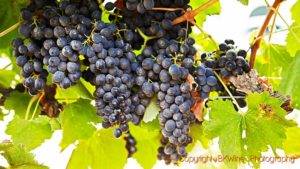 We had a question from a reader a while ago: “I discovered pinotage many years ago in Cape Town. But unfortunately, the quality has varied a lot. Are there any pinotage wines that you can recommend?” Pinotage is South Africa’s own grape, a cross between pinot noir and cinsault made back in 1925. The first commercial pinotage wine was made in 1959 in Stellenbosch. Although the grape variety is unique to the country, it has always been a bit in the background. It is planted on 8000 hectares (out of 115,000 hectares), which is a less than cabernet sauvignon and syrah. And as our reader pointed out, the quality has varied. Now the grape is making a comeback. Both producers and consumers are starting to appreciate it more. We will see more of pinotage in the future.
We had a question from a reader a while ago: “I discovered pinotage many years ago in Cape Town. But unfortunately, the quality has varied a lot. Are there any pinotage wines that you can recommend?” Pinotage is South Africa’s own grape, a cross between pinot noir and cinsault made back in 1925. The first commercial pinotage wine was made in 1959 in Stellenbosch. Although the grape variety is unique to the country, it has always been a bit in the background. It is planted on 8000 hectares (out of 115,000 hectares), which is a less than cabernet sauvignon and syrah. And as our reader pointed out, the quality has varied. Now the grape is making a comeback. Both producers and consumers are starting to appreciate it more. We will see more of pinotage in the future.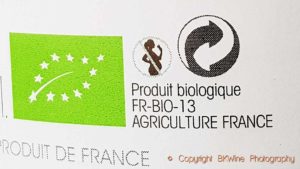 Demand for organic wine is increasing in France and also in Bordeaux. Wine merchants in Bordeaux have a hard time finding enough organic wine to meet demand. Bernard Farges, chairman of the Bordeaux producers’ organisation CIVB and the national Confédération Nationale des Vins AOC (CNAOC), has suggested that the organic rules be relaxed to more easily meet this demand. He has proposed that it should be possible to have only a part of a property organically certified and on the rest practice conventional farming. This is currently possible but only for a limited period of five years. A producer can begin the three-year conversion of his property a bit step by step. But after five years, the entire surface must unconditionally be organically certified or under conversion.
Demand for organic wine is increasing in France and also in Bordeaux. Wine merchants in Bordeaux have a hard time finding enough organic wine to meet demand. Bernard Farges, chairman of the Bordeaux producers’ organisation CIVB and the national Confédération Nationale des Vins AOC (CNAOC), has suggested that the organic rules be relaxed to more easily meet this demand. He has proposed that it should be possible to have only a part of a property organically certified and on the rest practice conventional farming. This is currently possible but only for a limited period of five years. A producer can begin the three-year conversion of his property a bit step by step. But after five years, the entire surface must unconditionally be organically certified or under conversion.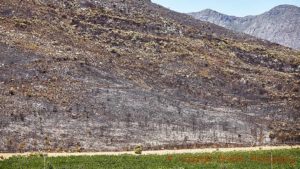 Fires in California are now more or less recurring annually. This year they have started unusually early. The winemakers had just started harvesting their grapes. Are the grapes at risk of being damaged by smoke? With off flavours as a result? Some producers in Napa and Sonoma are worried. But apparently, there is no straightforward answer to that question. Laboratories can analyse the grapes for specific chemicals. But it is not waterproof. There are many unknown factors about smoke taint. Sometimes it seems as if the damage only appears later, during the vinification. Much may depend on how close to the fire the vineyard is. Some wineries make a micro-vinification of a small volume of grapes. They ferment and can then see if there is any foul smell or taste from the grapes they think. Read more about the California fires:
Fires in California are now more or less recurring annually. This year they have started unusually early. The winemakers had just started harvesting their grapes. Are the grapes at risk of being damaged by smoke? With off flavours as a result? Some producers in Napa and Sonoma are worried. But apparently, there is no straightforward answer to that question. Laboratories can analyse the grapes for specific chemicals. But it is not waterproof. There are many unknown factors about smoke taint. Sometimes it seems as if the damage only appears later, during the vinification. Much may depend on how close to the fire the vineyard is. Some wineries make a micro-vinification of a small volume of grapes. They ferment and can then see if there is any foul smell or taste from the grapes they think. Read more about the California fires: 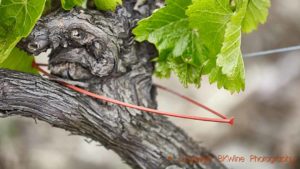 Biological control (biocontrol), or sustainable plant protection, is used more and more in the wine industry. It is, of course, a consequence of the fact that organic and sustainable viticulture is becoming more common. Biocontrol is methods of protecting the crop with natural mechanisms. The active substance must be found in nature or be extracted from a natural substance. It can also be synthetically made products that are identical to the natural ones. The idea of biological control is to get a balance, e.g. among the insects that are bothering you, instead of eradicating them.
Biological control (biocontrol), or sustainable plant protection, is used more and more in the wine industry. It is, of course, a consequence of the fact that organic and sustainable viticulture is becoming more common. Biocontrol is methods of protecting the crop with natural mechanisms. The active substance must be found in nature or be extracted from a natural substance. It can also be synthetically made products that are identical to the natural ones. The idea of biological control is to get a balance, e.g. among the insects that are bothering you, instead of eradicating them.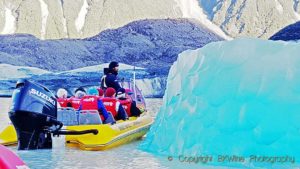 Patagonia’s glaciers are melting alarmingly fast. Viña San Pedro in Chile will soon launch a wine to support Glaciares Chilenos, a non-profit association that works to protect Patagonia’s glaciers. The wine is called South Cause and will be available as red, white and rosé. The wine will go on sale towards the end of the year.
Patagonia’s glaciers are melting alarmingly fast. Viña San Pedro in Chile will soon launch a wine to support Glaciares Chilenos, a non-profit association that works to protect Patagonia’s glaciers. The wine is called South Cause and will be available as red, white and rosé. The wine will go on sale towards the end of the year.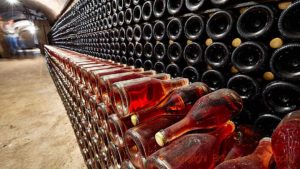 On October 21, 20 winegrowers from Alsace, Champagne and Burgundy will come to Copenhagen to present their wines to the Danish market. The winegrowers are small and independent and are looking for representation in Denmark and perhaps also in the neighbouring countries.
On October 21, 20 winegrowers from Alsace, Champagne and Burgundy will come to Copenhagen to present their wines to the Danish market. The winegrowers are small and independent and are looking for representation in Denmark and perhaps also in the neighbouring countries. Birds munching on ripe grapes can be a big problem in the vineyards. We have seen it in New Zealand and South Africa; it occurs in Australia and elsewhere around the world. However, from what we have seen it is not a big problem in Europe, at least not in France.
Birds munching on ripe grapes can be a big problem in the vineyards. We have seen it in New Zealand and South Africa; it occurs in Australia and elsewhere around the world. However, from what we have seen it is not a big problem in Europe, at least not in France.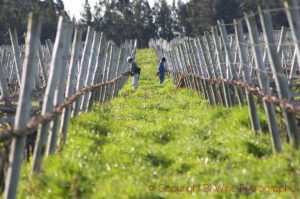 We continue our series of article on organic wines and similar methods. The environmental debate is not a black-and-white issue. Organic growers inspire conventional and sustainable winegrowers. Non-organic growers use many of the organic methods. At the same time, some of the organically approved products are controversial. In this second article in our series on organics, biodynamics, sustainable and “natural”, we look in more detail at what it means to be organic in the vineyard. Are there only benefits, or are there also disadvantages to organic farming?
We continue our series of article on organic wines and similar methods. The environmental debate is not a black-and-white issue. Organic growers inspire conventional and sustainable winegrowers. Non-organic growers use many of the organic methods. At the same time, some of the organically approved products are controversial. In this second article in our series on organics, biodynamics, sustainable and “natural”, we look in more detail at what it means to be organic in the vineyard. Are there only benefits, or are there also disadvantages to organic farming?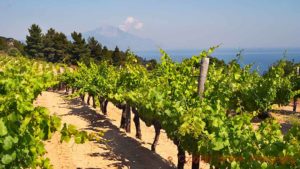 If we get the opportunity to taste Greek wines, we never hesitate. Neither should you. Recently, we enjoyed tasting wines from Domaine Agrovision. This is a 25-hectare estate in Lerissos, located just at the beginning of the third “finger” of the beautiful peninsula Halkidiki in Macedonia in northern Greece. The vineyards are situated between four and ten kilometres from the sea, opposite the island of Ammouliani. There is a view of Mount Athos further down the finger. We have not visited Agrovision, but we have been to Halkidiki and know that this is an immensely beautiful region.
If we get the opportunity to taste Greek wines, we never hesitate. Neither should you. Recently, we enjoyed tasting wines from Domaine Agrovision. This is a 25-hectare estate in Lerissos, located just at the beginning of the third “finger” of the beautiful peninsula Halkidiki in Macedonia in northern Greece. The vineyards are situated between four and ten kilometres from the sea, opposite the island of Ammouliani. There is a view of Mount Athos further down the finger. We have not visited Agrovision, but we have been to Halkidiki and know that this is an immensely beautiful region.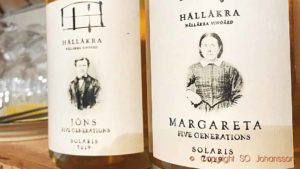 “Ambitious” is the short summary of the visit to Hällåkra winery (Hällåkra Vingård) in Skåne (Scanie). Framed with wheat fields, oilseed rape and sugar beet in Sweden’s granary, neat rows of vines grow. Both the farmers in the area and Sweden’s wine elite shook their heads when Håkan Hansson planted the first vine in 2003. Today we can state that it is excellent to make wine in Sweden. On the other hand, connecting the aroma and taste experience to the old world’s often well-known points of reference is not a good idea. It’s well done, it’s challenging and it’s rich in new impressions. The winemaker has succeeded but it is with a completely new palette of stunning aromas and flavours.
“Ambitious” is the short summary of the visit to Hällåkra winery (Hällåkra Vingård) in Skåne (Scanie). Framed with wheat fields, oilseed rape and sugar beet in Sweden’s granary, neat rows of vines grow. Both the farmers in the area and Sweden’s wine elite shook their heads when Håkan Hansson planted the first vine in 2003. Today we can state that it is excellent to make wine in Sweden. On the other hand, connecting the aroma and taste experience to the old world’s often well-known points of reference is not a good idea. It’s well done, it’s challenging and it’s rich in new impressions. The winemaker has succeeded but it is with a completely new palette of stunning aromas and flavours.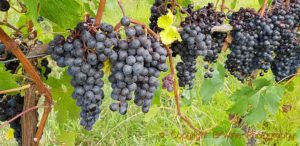 France and Australia are the two major countries producing syrah (or shiraz). But the grape is grown in many countries around the world. Does the character change depending on where the grapes grow? Absolutely. Compare shiraz from Australia with syrah from the Northern Rhône Valley. The differences will be significant. But you will probably find that they have some features in common.
France and Australia are the two major countries producing syrah (or shiraz). But the grape is grown in many countries around the world. Does the character change depending on where the grapes grow? Absolutely. Compare shiraz from Australia with syrah from the Northern Rhône Valley. The differences will be significant. But you will probably find that they have some features in common.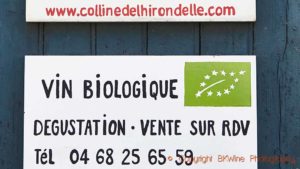 We often hear organic wine growers saying that the organic way of thinking should continue in the cellar. But what does that mean? The rules for organic wine in the cellar has to do with what additives and techniques you are allowed during the vinification to assure that the production of the wine runs as smoothly as possible. By and large, these are not any strange processes or products. But big headlines in newspapers shouting “70 different additives in wine!” makes people wonder. Are there really that many additives in a wine? Is wine concocted by blending a whole lot of different “ingredients”? Of course not.
We often hear organic wine growers saying that the organic way of thinking should continue in the cellar. But what does that mean? The rules for organic wine in the cellar has to do with what additives and techniques you are allowed during the vinification to assure that the production of the wine runs as smoothly as possible. By and large, these are not any strange processes or products. But big headlines in newspapers shouting “70 different additives in wine!” makes people wonder. Are there really that many additives in a wine? Is wine concocted by blending a whole lot of different “ingredients”? Of course not.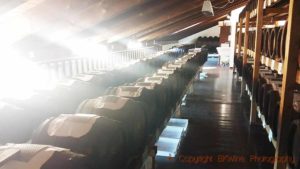 There is wine vinegar, balsamic vinegar, and then there is aceto balsamico tradizionale from Modena. Modena is a town in the Italian region of Emilia-Romagna. The sports car enthusiasts know that they make Ferrari and Maserati here. For the gastronomic connoisseur, however, Modena is the town where they make the unique balsamico tradizionale.
There is wine vinegar, balsamic vinegar, and then there is aceto balsamico tradizionale from Modena. Modena is a town in the Italian region of Emilia-Romagna. The sports car enthusiasts know that they make Ferrari and Maserati here. For the gastronomic connoisseur, however, Modena is the town where they make the unique balsamico tradizionale.
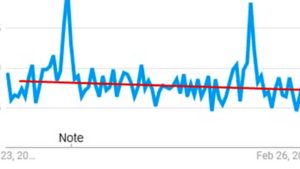 A while ago, I was part of a discussion panel at the “Wine Media Conference” on the theme “can wine writers produce better articles by including more about travel”. It was a discussion that in practice came to be more about how to write well. But it was also about how the writing “business”, and in particular the wine writing business, has developed in recent years, plus some thoughts on future developments.
A while ago, I was part of a discussion panel at the “Wine Media Conference” on the theme “can wine writers produce better articles by including more about travel”. It was a discussion that in practice came to be more about how to write well. But it was also about how the writing “business”, and in particular the wine writing business, has developed in recent years, plus some thoughts on future developments.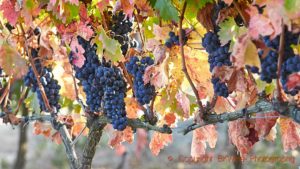
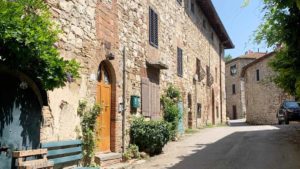 Chianti Classico is moving towards a regional sub-division similar to what has already been done in Barolo and Barbaresco. The goal is that the wine region’s eight municipalities should be allowed on the label at the end of this year. The Mazzei family goes ahead of the time and releases three new “cru” from Chianti Classico.
Chianti Classico is moving towards a regional sub-division similar to what has already been done in Barolo and Barbaresco. The goal is that the wine region’s eight municipalities should be allowed on the label at the end of this year. The Mazzei family goes ahead of the time and releases three new “cru” from Chianti Classico.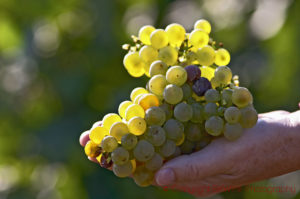 Chardonnay is grown all over the world. It can handle many kinds of climate and soil types. It is often oak aged but not always. All this means that chardonnay is available in many different styles and tastes. A fun and pleasant way to discover some of these different styles is to organize a wine tasting and compare chardonnay from different countries. A classic and crispy Chablis from France is an obvious choice for a typical example of the grape’s character without the influence of oak. Avoid Chablis premier cru and grand cru as these are sometimes oak-aged.
Chardonnay is grown all over the world. It can handle many kinds of climate and soil types. It is often oak aged but not always. All this means that chardonnay is available in many different styles and tastes. A fun and pleasant way to discover some of these different styles is to organize a wine tasting and compare chardonnay from different countries. A classic and crispy Chablis from France is an obvious choice for a typical example of the grape’s character without the influence of oak. Avoid Chablis premier cru and grand cru as these are sometimes oak-aged.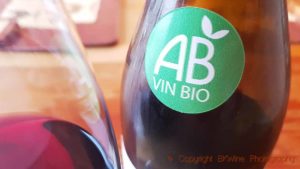 The fourth article in our series on organic (etc.) wines. It is not at all as complicated as some say.
The fourth article in our series on organic (etc.) wines. It is not at all as complicated as some say.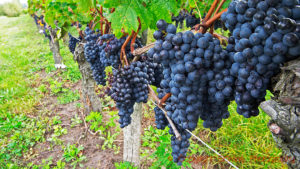
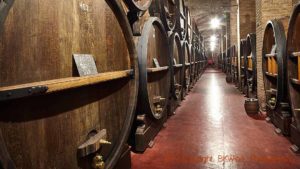 Malbec is best known for making easy-drinking charming wines but it can also make extraordinary long-lived wines. At Bodega Weinert in Lujan de Cuyo, winemaker Hubert Weber knows exactly what it takes to bring out the best character from this excellent grape. And his wine making principles are quite different in almost all aspects from most others.
Malbec is best known for making easy-drinking charming wines but it can also make extraordinary long-lived wines. At Bodega Weinert in Lujan de Cuyo, winemaker Hubert Weber knows exactly what it takes to bring out the best character from this excellent grape. And his wine making principles are quite different in almost all aspects from most others.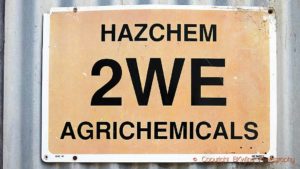 Since a few years back, it is mandatory for all websites to inform visitors about e.g. that you set cookies. Failure to do so violates the EU GDPR rules. I would think that in practice, probably 9 out of 10, or more, sites don’t follow the rules, including most of those who do have a cookie warning (“cookie banner”). It is not enough to just have a small warning text. You must also have a public privacy policy (how many sites have it?) and several other things. We have now updated our
Since a few years back, it is mandatory for all websites to inform visitors about e.g. that you set cookies. Failure to do so violates the EU GDPR rules. I would think that in practice, probably 9 out of 10, or more, sites don’t follow the rules, including most of those who do have a cookie warning (“cookie banner”). It is not enough to just have a small warning text. You must also have a public privacy policy (how many sites have it?) and several other things. We have now updated our 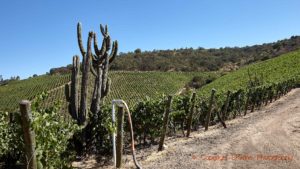 We start the tour in Buenos Aires and end in Santiago de Chile. In between, we will visit Mendoza, Argentina’s largest wine region. We will taste malbec of course, but also many other grape varieties. Our bus will take us across the mighty Andes to Chile where we visit cool coastal regions such as Casablanca and San Antonio and beautiful Colchagua in the inland. A journey you will not easily forget.
We start the tour in Buenos Aires and end in Santiago de Chile. In between, we will visit Mendoza, Argentina’s largest wine region. We will taste malbec of course, but also many other grape varieties. Our bus will take us across the mighty Andes to Chile where we visit cool coastal regions such as Casablanca and San Antonio and beautiful Colchagua in the inland. A journey you will not easily forget.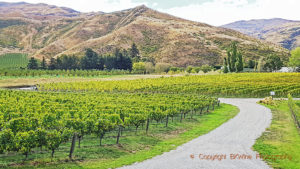 New Zealand is surrounded by water. The water affects the climate in almost all wine regions on the island. It is relatively cool and consequently the grapes here thrive in slightly cool climates, such as sauvignon blanc, pinot noir, pinot gris and riesling. Although sauvignon blanc dominates, there is today a great desire to expand the grape portfolio and to offer something else. New Zeeland is an exciting country to discover. Both for the wines and the extraordinary landscape.
New Zealand is surrounded by water. The water affects the climate in almost all wine regions on the island. It is relatively cool and consequently the grapes here thrive in slightly cool climates, such as sauvignon blanc, pinot noir, pinot gris and riesling. Although sauvignon blanc dominates, there is today a great desire to expand the grape portfolio and to offer something else. New Zeeland is an exciting country to discover. Both for the wines and the extraordinary landscape.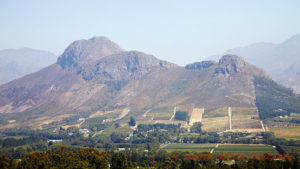 Join us on this tour to beautiful South Africa and meet some of the country’s most talented winemakers. We visit classic Franschhoek and Stellenbosch, trendy Swartland and cool climate regions such as Elgin and Hemel-en-Aarde. We visit Cape Town. We will discover South African cuisine and we will have delicious meals at the wineries. Safari with many animals and beautiful nature is offered after the tour if you want.
Join us on this tour to beautiful South Africa and meet some of the country’s most talented winemakers. We visit classic Franschhoek and Stellenbosch, trendy Swartland and cool climate regions such as Elgin and Hemel-en-Aarde. We visit Cape Town. We will discover South African cuisine and we will have delicious meals at the wineries. Safari with many animals and beautiful nature is offered after the tour if you want. Nowhere do you see as many grand chateaux as in Bordeaux. Just driving around looking at them is an experience. Even better of course, is visiting some of these Bordeaux chateaux and also having luxurious lunches here, accompanied with world famous wines. Join us in Bordeaux for a thrilling experience.
Nowhere do you see as many grand chateaux as in Bordeaux. Just driving around looking at them is an experience. Even better of course, is visiting some of these Bordeaux chateaux and also having luxurious lunches here, accompanied with world famous wines. Join us in Bordeaux for a thrilling experience.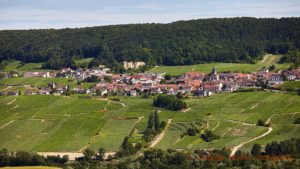 Champagne is so famous and prestigious that you sometimes forget the people behind the wine. On this tour we will meet smaller growers as well as bigger houses, all of them playing important roles in the champagne wine industry. Learn how to make a champagne and how you can make it even better.
Champagne is so famous and prestigious that you sometimes forget the people behind the wine. On this tour we will meet smaller growers as well as bigger houses, all of them playing important roles in the champagne wine industry. Learn how to make a champagne and how you can make it even better.




